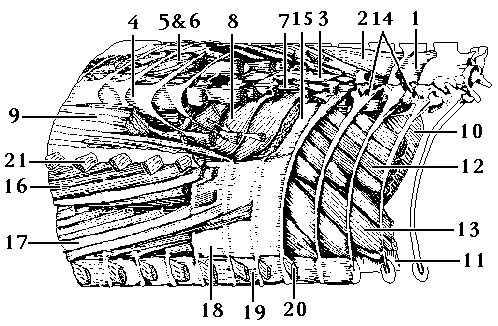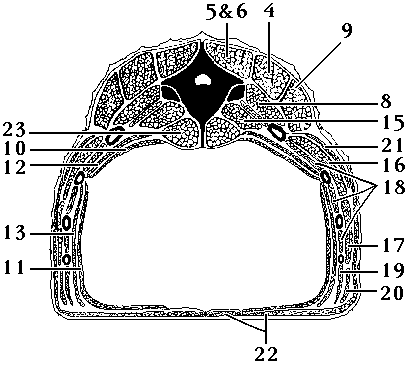

Diagramatic lateral view of the trunk musculature of a colubrid snake (Masticophis) (From Cundall, 1987; based on description of Mosauer, 1935; terminology after Gasc, 1981; Copyright © 1987 by McGraw-Hill, Inc.; reprinted with permission). Muscle tissue is indicated by solid lines, tendons by dashed lines. Anterior is to the right. Numbers above the vertebrae indicate the number of vertebrae from the anterior origin of the muscle-tendon chain. Muscles: 1, interneuralis; 2a, medial head of multifidis; 2b, lateral head of multifidis; 3, interarticularis superior; 4, longissimus dorsi; 5, spinalis; 6, semispinalis; 7, interarticularis inferior; 8, levator costa; 9, iliocostalis; 10, transversus dorsalis; 11, transversus ventralis; 12, obliquus internus dorsalis; 13, obliquus internus ventralis; 14, tuberculocostalis; 15, intercostalis quadrangularis; 16, supracostalis lateralis superior; 17, supracostalis lateralis inferior; 18, intercostalis externus; 19, intercostalis ventralis.

Diagramatic oblique view of the trunk muscles of a viperid snake (Cerastes) showing the complexity of the muscle and tendon arrangements (From Cundall, 1987; redrawn from Gasc, 1974; Copyright © 1987 by McGraw-Hill, Inc.; reprinted with permission). Numbers indicate muscles as in previous figure, with the addition of 20, costocutaneous inferior; 21, costocutaneous superior.

Diagramatic cross-sectional view of the trunk muscles of a crotalid snake
(Agkistrodon) (From Cundall, 1987; modified after Gasc, 1981; Copyright
© 1987 by McGraw-Hill, Inc.; reprinted with permission). Numbers indicate
muscles as in previous figure, with the addition of 22, scutali-interscutali
complex; 23, parapophyseo-hypapophyseus.
Cundall, David. 1987. Functional morphology. In: (R. A. Seigel, J. T. Collins, and S. S. Novak, eds.), Snakes: Ecology and Evolutionary Biology. McGraw Hill Publ. Co., New York.
Gasc, Jean-Pierre. 1974. L'interpretation fonctionnelle de l'appareil musculo-squelettique de l'axe vertebral chez les Serpents (Reptilia). Mémoires du Muséum National D'Histoire Naturelle, Série A, Tome 83, pp. 1-182.
Gasc, Jean-Pierre. 1981. Axial musculature. In: (C. Gans and T. S. Parsons, eds.), Biology of the Reptilia, volume 11 (Morphology C), pp. 355-435. Academic Press, New York.
Mosauer, Walter. 1935. The myology of the trunk region of snakes and
its significance for ophidian taxonomy and phylogeny. University of California
at Los Angeles Publications in Biological Sciences, Volume 1, pp. 81-120.
|
|
|
|
|
|
|
|